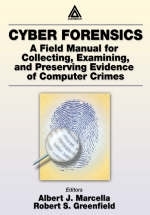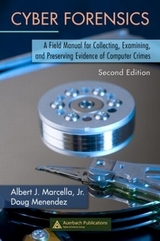
Cyber Forensics
Auerbach (Verlag)
978-0-8493-0955-7 (ISBN)
- Titel erscheint in neuer Auflage
- Artikel merken
Given our increasing dependency on computing technology in daily business processes, and the growing opportunity to use engineering technologies to engage in illegal, unauthorized, and unethical acts aimed at corporate infrastructure, every organization is at risk. Cyber Forensics: A Field Manual for Collecting, Examining, and Preserving Evidence of Computer Crimes provides a comprehensive, highly usable, and clearly organized resource to the issues, tools, and control techniques needed to successfully investigate illegal activities perpetuated through the use of information technology.
Traditional forensics professionals use fingerprints, DNA typing, and ballistics analysis to make their case. Infosec professionals have to develop new tools for collecting, examining, and evaluating data in an effort to establish intent, culpability, motive, means, methods and loss resulting from e-crimes. The field bible for infosecurity professionals, this book introduces you to the broad field of cyber forensics and presents the various tools and techniques designed to maintain control over your organization.
You will understand how to:
Identify inappropriate uses of corporate IT
Examine computing environments to identify and gather electronic evidence of wrongdoing
Secure corporate systems from further misuse
Identify individuals responsible for engaging in inappropriate acts taken with or without corporate computing systems
Protect and secure electronic evidence from intentional or accidental modification or destruction
Cyber Forensics: A Field Manual for Collecting, Examining, and Preserving Evidence of Computer Crimes provides a set of varied resources for anyone required to look under the hood and behind closed doors of a virtual world to gather evidence and to establish credible audit trails of electronic wrong doing. Knowing how to identify, gather, document, and preserve evidence of electronic tampering and misuse makes reading this book and using the forensic audit procedures it discusses essential to protecting corporate assets.
Introduction
SECTION I: CYBER FORENSICS
The Goal of the Forensic Investigation, Carol Stucki
How to Begin a Nonliturgical Forensic Investigation, Carol Stucki
The Liturgical Forensic Examination: Tracing Activity on a Windows-Based Desktop, Robert E. Greenfield
Basics of Internet Abuse: What Is Possible and Where to Look under the Hood, John W. Rado
Tools of the Trade: Automated Tools Used to Secure a System throughout the Stages of a Forensic Investigation, Brent Deterdeing
Network Intrusion Management and Profiling, Steven Schlarman
Cyber Forensics and the Legal System, Abigail Abraham
SECTION II: FEDERAL AND INTERNATIONAL GUIDELINES
Searching and Seizing Computers and Obtaining Electronic Evidence
Computer Crime Policy and Programs
International Aspects of Computer Crime
Privacy Issues in the High-Tech Context, The Department of Justice Privacy Council
Critical Infrastructure Protection
Electronic Commerce: Legal Issues, The Electronic Commerce Working Group, Department of Justice
Legal Considerations in Designing and Implementing Electronic Processes: A Guide for Federal Agencies
Encryption
Intellectual Property
SECTION III: FORENSICS TOOLS
Forensic and Security Assessment Tools
How to Report Internet-Related Crime
Internet Security: An Auditor's Basic Checklist
SECTION IV: APPENDICES
Glossary
Recommended Reading List
Index
| Erscheint lt. Verlag | 23.1.2002 |
|---|---|
| Zusatzinfo | 57 Halftones, black and white; 60 Illustrations, black and white |
| Verlagsort | London |
| Sprache | englisch |
| Maße | 178 x 254 mm |
| Gewicht | 803 g |
| Themenwelt | Informatik ► Netzwerke ► Sicherheit / Firewall |
| Informatik ► Theorie / Studium ► Kryptologie | |
| Recht / Steuern ► Strafrecht ► Kriminologie | |
| ISBN-10 | 0-8493-0955-7 / 0849309557 |
| ISBN-13 | 978-0-8493-0955-7 / 9780849309557 |
| Zustand | Neuware |
| Haben Sie eine Frage zum Produkt? |
aus dem Bereich



